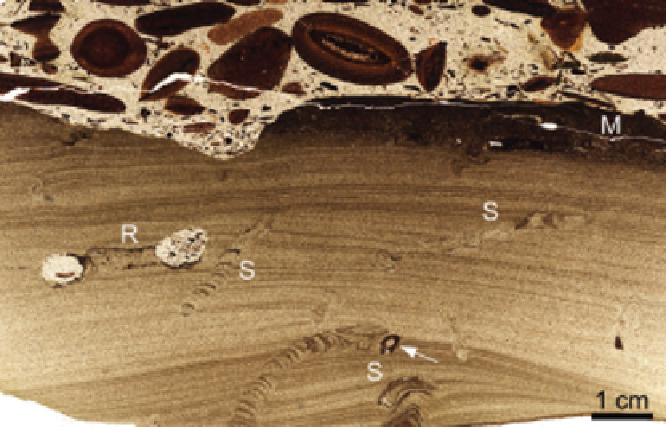Environmental Engineering Reference
In-Depth Information
FIGURE 4
Part of a large-scale thin section displaying a vertical section through a Lower Jurassic
calcite concretion from the clay pit Grimmen, northern Germany. The visualization in transmitted
light via a high-resolution flatbed scanner reveals an insightful ichnofabric that otherwise would be
invisible. In its lower part, siltstone with low-angle cross-lamination contains two generations of
burrows: (1) actively backfilled meniscate burrows (S), produced by scaphopods (arrow), and (2)
a horizontal spreite burrow (
Rhizocorallium
, R) with a passively filled marginal tube around an
actively produced spreite. A mixed layer (M) with complete bioturbation and enriched organic mat-
ter is developed at the top of the siltstone bed, but it is partly or completely cut through by an erosion
surface with a bioclastic conglomerate above it.
applied in homogeneous carbonates (
Knaust, 1998
) and siliciclastics (
Garton
and McIlroy, 2006
) to enhance the visibility of trace fossils and bioturbate struc-
tures (
Fig. 4
). Semiconsolidated samples are commonly impregnated with
low-viscosity and stained epoxy resin before the preparation of thin sections.
In order to achieve a better contrast and visualization, it might be worthwhile
to diverge from the commonly applied standard thickness of 0.03 mm but
prepare it slightly thicker. For imaging, a high-resolution flatbed scanner is suit-
able. Chemical staining can be applied to emphasize certain structures in
carbonates (see
Miller, 1988
).
3.3 Optical Microscopy
Microscopical analysis of trace fossils in reflected or transmitted light is an
important method for ichnological investigations. Given a size range from bac-
teria up to giants, a wealth of organism groups does exist at the lower size limit
with potential tracemakers, which may produce an exceeding number of mor-
phologically different traces compared to their macroscopic counterparts. Thus,
microscopy becomes essential in the analysis of traces left by bacteria, fungi,
and meiobenthic organisms.










Search WWH ::

Custom Search